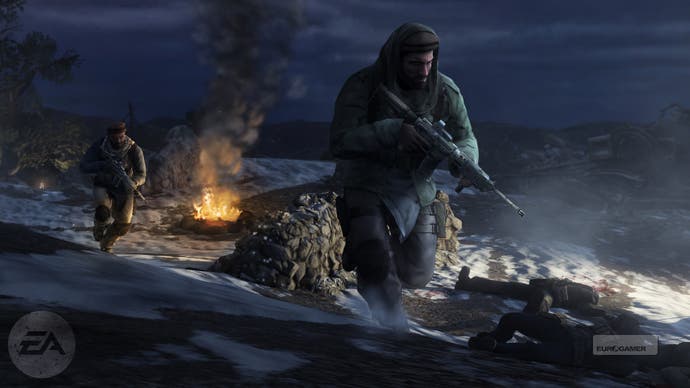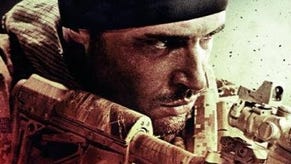Medal of Honor
Tiers of War.
War is serious business, and if you doubt how seriously Medal of Honor developers Danger Close and DICE are taking the conflict their game portrays, consider the public explanation for the decision to change your multiplayer opponents from "Taliban" to "Opposing Force". It was taken "for the men and women serving in the military and for the families of those who have paid the ultimate sacrifice," according to executive producer Greg Goodrich, because "this franchise will never wilfully disrespect, intentionally or otherwise, your memory and service." Serious words delivered with humility, but still words from a man who at some point during the game's development sat in a meeting where someone said, "Yes, let's have a quad-bike level."
Whereas films like The Hurt Locker evade accusations of insensitivity through their dispassionate and meticulous observations of the conflicts they portray, Medal of Honor ostensibly dodges the issue by not really being about anything except what's happening on-screen. There are no politics – there's arguably a subtext about the dehumanisation of US military personnel, but the B-movie story dialogue and CG cut-scenes borrowed from 1998 do little to convince you it was deliberate – and beyond a stylish Modern Warfare-inspired introductory sequence there's relatively little to explain the context of the actions you're taking as a Navy SEAL, a US Army Ranger, a Tier 1 Operator or an Apache gunner.
Still, this tunnel-vision approach to the campaign is hardly disrespectful to the troops Danger Close so venerates. It's set at the outset of the war in Afghanistan and chronicles the efforts of soldiers fighting over the complicated terrain of Shahikot Valley, a sprawling expanse of rock, sand, dust, snow and militants. We see how the conflict begins with intelligence-gathering and surgical incisions into Taliban and Al Qaeda strongholds and outposts, before the pressure for results from Washington leads to some bad decisions, near-defeat and considerable heroics.

As is the fashion these days, Medal of Honor is heavy on jargon, burst-firing and switches of perspective. Much of the short campaign is spent pausing behind rocks to shoot at rapidly spawning Taliban or Al Qaeda forces, tugging the left trigger to quickly iron-sight an enemy and then bursting with the right trigger to drop him. You do this in valleys and villages, on hillsides and mountain peaks, and peering through night-vision goggles in the dead of night or darkness of caves. When the next guy is down you move to the next rock. It's slick, if not exotic.
Enemies are pretty daft. These guys are supposed to have incredible knowledge of the terrain, but all they really do is hide behind rocks, helpfully popping their heads up at intervals, or run obligingly across open ground between cover points. When they're supported by gun emplacements or approach in overwhelming numbers you may find yourself tested (at least on the Hard difficulty), but generally you'll already have their number.
That's true of the US Army Ranger sections, in any event, and also for some of the SEAL and Tier 1 elements, but there is more variety to the latter, and it's also where Medal of Honor's obsession with jargon really pays off.

We've heard soldiers inquiring about whether fire missions are danger-close for the convoy before, of course, but fittingly for a studio actually called Danger Close the developer uses military lingo more intensively, and successfully conveys the delicate balance of tension and self-control Special Forces must master to survive and prosper. "Danger close - service targets further north," your SEAL team leader barks into his radio as bombs from air support threaten to blow your squad to pieces in spectacular fashion. "Maintain noise discipline," he whispers afterwards as the dust settles.
Air support is a constant fixture and another element that heightens your sense of involvement. You're frequently invited to paint targets for incoming F-15s ("fast movers") and drones, but it's when the delicacy of that network of assets is stressed and strained that the game does its best line in high drama. There's an assault where you need to suppress a powerful enemy gun emplacement with your M249 SAW, all the while your squad-mates bravely advance to mark it with red phosphorous. Shortly afterward, you're caught out in a valley by an IED and forced to defend against waves of AK-47 and RPG-toting Taliban forces as the world falls apart around you, until you genuinely feel as though you can't save yourself.
The outstanding example of this blend of jargon and multi-faceted warfare, though, is an Apache gunfighter mission halfway through the campaign. It's an on-rails level where you mostly push buttons to fire guns at painted locations, or fire cannons and hydra missiles as your bird swoops and strafes complicated targets, but thanks to the sense of co-ordination and abstract dialogue you lose yourself in the drama of incomprehensibly deft technical warfare.






